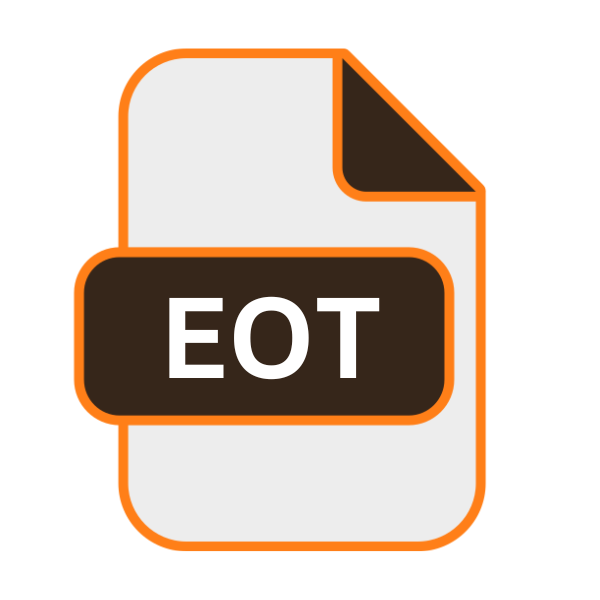.EOT File Extension

Embedded OpenType Font
| Developer | Microsoft |
| Popularity | |
| Category | Font Files |
| Format | .EOT |
| Cross Platform | Update Soon |
What is an EOT file?
The .EOT file extension is synonymous with Embedded OpenType Fonts, a format specifically designed for web use.
It was created by Microsoft to address the need for a font format that could be embedded within web pages and displayed consistently across different browsers and operating systems.
The primary objective of .EOT files are to ensure that web developers can utilize custom fonts without worrying about compatibility issues.
More Information.
Upon its introduction, the primary purpose of .EOT files was to enable web designers to use custom fonts without relying solely on the limited set of fonts pre-installed on users’ devices.
This addressed a longstanding issue in web design, where designers were often constrained by the availability of fonts across different platforms.
.EOT files offered a solution by allowing fonts to be embedded directly into web pages, ensuring consistent rendering across various browsers and operating systems.
Origin Of This File.
The genesis of .EOT files can be traced back to the early 2000s when web typography was in its nascent stage.
Microsoft recognized the limitations of existing font formats for web use and spearheaded the development of EOT to overcome these challenges.
By embedding fonts directly into web pages, Microsoft aimed to enhance the aesthetics and readability of online content while maintaining cross-browser compatibility.
File Structure Technical Specification.
.EOT files are essentially a compact, self-contained package that includes both the font data and the necessary metadata for embedding. They utilize a proprietary compression algorithm to minimize file size while preserving font quality.
The structure of .EOT files consist of header information, font data tables, and embedding permissions. The font data tables contain glyph outlines, hinting instructions, and other essential information required for rendering the font accurately.
How to Convert the File?
To convert font files to the .EOT format, you have several options depending on your operating system and preferences. If you’re using Windows, you can utilize the Microsoft Web Embedding Fonts Tool (WEFT).
Simply download WEFT from Microsoft’s website, open the application, import your font file, customize embedding options to your liking, and then generate the .EOT file.
You can explore online font conversion services such as Transfonter or Online Font Converter, which work across macOS, Windows, and Linux.
Upload your font file to the converter, select “Embedded OpenType (EOT)” as the output format, initiate the conversion process, and download the resulting .EOT file once it’s ready.
For more advanced users on any operating system, FontForge offers a powerful solution. Download and install FontForge, open your font file, select “Generate Fonts,” choose “Embedded OpenType (EOT)” as the output format, and save the converted .EOT file to your desired location.
Advantages And Disadvantages.
Advantage:
- Cross-Browser Compatibility: .EOT files ensure consistent font rendering across different web browsers, including Internet Explorer, Firefox, Chrome, and Safari.
- Embedded Licensing: .EOT files support font embedding permissions, allowing font creators to specify usage rights and restrictions, thereby protecting their intellectual property.
- Improved Performance: Due to their compressed nature, .EOT files offer faster load times compared to other font formats, enhancing the overall performance of web pages.
Disadvantage:
- Limited Browser Support: While .EOT files are widely supported across major browsers, some newer browsers and mobile devices may not fully support this format, necessitating alternative font formats for broader compatibility.
- Proprietary Format: .EOT files are proprietary to Microsoft, which can pose challenges for developers working in non-Microsoft environments or seeking open standards.
- Complex Conversion Process: Converting fonts to the .EOT format can be a complex and time-consuming process, requiring specialized tools and expertise.
How to Open EOT?
Open In Windows
You can open .EOT files on Windows by double-clicking on the file. If you have font management software installed, such as FontForge or Microsoft WEFT, you can also use these programs to open and view .EOT files.
Open In Linux
In Linux, you can use font management tools like FontForge or online converters to open and view .EOT files.
You may need to convert the .EOT file to a different font format compatible with Linux, such as TrueType (.TTF) or OpenType (.OTF), using conversion software.
Open In MAC
Similar to Linux, macOS may require you to convert .EOT files to a compatible format like TrueType or OpenType using conversion tools such as FontForge.
You can also use online converters or you can try font management software available for macOS.
Open In Android
Android devices typically do not natively support .EOT files. To use custom fonts in Android apps, developers often convert.
.EOT files to other formats like TrueType (.TTF) or OpenType (.OTF) and include them in the app’s assets. The app then uses the appropriate APIs to load and display these fonts.
Open In IOS
Similarly to Android, iOS devices do not directly support .EOT files. Developers convert .EOT files to compatible formats such as TrueType or OpenType and include them in their iOS apps.
The app then utilizes UIFont or NSAttributedString APIs to use these custom fonts in the user interface.
Open in Others
For other platforms not covered above, such as embedded systems or specialized devices, opening .EOT files may require custom solutions.
This could involve converting the .EOT files to a compatible format or developing software specifically tailored to handle .EOT files on those platforms.













